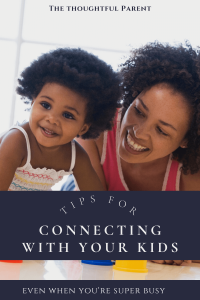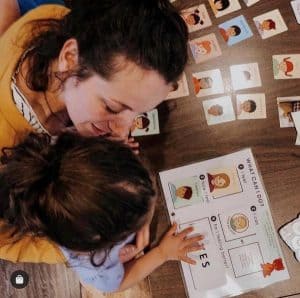As parents, we know that the emotional connection with our kids is really the foundation of our relationship. Without connecting with kids, we can feel that we are simply cooks, chauffeurs, and homework masters instead of parents to our children. With all the tasks that have to get done it a day, however, sometimes the real emotional connection can slip away.
With this in mind, I’m so glad that I found Marie Levey-Pabst’s website Create Balance. She offers parents real-life strategies for balancing responsibilities and still connecting with their kids. I’m pleased that she agreed to write a guest post today discussing this timely topic.
When I became a parent, one of the most surprising parts contradictions I faced was both how busy I felt, and how little I got done. There have been countless nights when I have collapsed on the couch after the bedtime routine, looked at the clock and wondered “what did I do all day?” These nights happened when I was a new mom with a newborn, and even when both my kids became school-aged.
On those nights I know we were all busy doing important things. I know that everyone got fed, kept safe, and, on a good day, bathed. But I still felt both unproductive and that nagging feeling of missing out. Even on weekends when I was with my kids all day that feeling of “what just happened?” lingered.
Now, it’s no secret that all of us parents get a lot done. Whether we’re in those early sleep-deprived days of feeding a child, changing diapers, and going to weekly doctor appointments, or in those later days of lunch making, field-trip chaperoning and chauffeuring, we are busy. But many of us wonder, are we busy doing the right things? Are we really connecting with our kids in a meaningful way?

It’s very possible to get through a whole day doing all that needs to get done but still not doing the things that matter most to us. We have times when we need to make sure the laundry is done, dinner is cooked, and work projects are dealt with. But then we realize, as we get to the end of the day, we never really sat and played with our kids, or listened closely to them, or read them a book. We know this form of connecting with kids is important, both for our children’s development and for our own fulfillment and joy. In fact, Amy’s recent post about connecting with kids highlights the importance of this connection.
How To Connect with Your Child?

When it comes to striking a balance between the various parts of our life, be they “work” and “home” or getting things done and being present and focused parents, there is one truism that I always come back to. We must:
Maximize time and energy on the things that matter most.
Minimize time and energy on the rest
Sound good right? So, let’s talk about actual strategies that can make this happen!
Maximize your time and energy on the things that matter most
Strategy #1: Connect priorities with action
A common human conundrum is that the things we say we value most are not the things we spend the most time on. But the disconnect is not usually about a lack of will-power. Often, it is about a lack of actionable plans. It’s one thing to say we value connection time with our children. But without an action that correlates with that value, it’s hard to move from wanting to doing.
Take a moment here and think about when you have felt the most present and connected with your child. Is it while reading a book? Playing outside? Building things? Playing a card game? Just as a quick example, when I did this exercise I realized that I am able to be far more focused and connected to my kids when we are either in the playroom area of our house OR outside the house – at the park or the library. For me that meant I could make my priorities more actionable this way: I went from saying “I want to be more present when I’m with my kids” to “I want to spend more time doing activities with my kids outside the house”
Connect and learn about emotions with the My Feelings Card set
Strategy #2: Sacred Time
Planning for action is a great step, but we all still need time to TAKE action. This is where Sacred Time comes in. The word “sacred” usually refers to religion. There are sacred holidays, sacred time to commune with one’s God, etc. But sacred also means “untouchable” or “protected.”
Creating sacred time simply means that you create a few specific blocks of time to focus on one of your actionable priorities. These are not times for multi-tasking. These are not times that can be moved around or just put off until tomorrow. These are the times that are untouchable. They are an appointment with yourself and your values (in this case, connecting with kids).
For example, in my quest to create more connection time with my son, I stopped trying to do something with him “every day” (a project that was too often derailed by work and household demands) and instead created one sacred block of a time a week for me and him to spend focused time together. For us, that is Thursday afternoons, when my husband can watch our daughter, and I can pick up my son from school. We have 2 hours to do whatever he pleases, and we have gone to parks, the library, even out for tea at a local coffee shop. The beauty of this time is that it is predictable, attainable, and special for me and my son. So, in the weeks where I’m not home – or not as present – as much as I would like, my son and I both hold on to our special plans for Thursday to get us through.
You can get more details about sacred time (and 5 specific strategies for making it happen) here.
Minimize time and energy on the rest
Of course, making time for the actions that lead to connection with our children – even small blocks of sacred time – is a challenge because of all the other things we have to do on a daily basis. That is why it’s not enough to just spend more time on connection with our children – we must find ways to minimize the tasks that are taking up more time and energy than we want them to.
Strategy #3: The Recurring to-do List
One of the main reasons we have trouble connecting with kids isn’t actually about time. It’s about bandwidth. We may be with our kids after school, or on the playground. We are physically there with them. But mentally we are in a whole other world. Our to-do list is running through our heads. We are remembering that we need to email so-and-so, thinking about what to make for dinner, planning our next meeting in our head.
A recurring to-do list is one way to give at least some of those thoughts a place to live. It works like this:
You start by listing all the tasks you do in a daily and weekly (and monthly if you are ambitious) schedule.
We all have tasks like this at home, and at work. If you work in accounting, you know that the last couple weeks of every quarter are going to be busy with specific tasks. As a teacher, I always knew that I would have to take attendance and plan lessons every day, grade assignments every week, and enter progress report marks every six weeks. In parenting life, I have daily tasks like packing lunches, cleaning dishes, and checking homework.
You take those tasks and you write them out on a schedule by day or week.
You can do it on your phone using an app like Todist or Wunderlist. You can do it on paper. You can type it and print multiple copies. Then you have a master to-do list. You don’t need to remember all the things to do every evening because the list is already there. You can even add to it as you remember things you need to do today, tomorrow, or by Friday. If you would like to learn more and download an example recurring to-do list, check this out.
A recurring to-do list that is ready to go every day, week, month, or quarter takes saves you all the energy of remembering what is due and re-writing a to-do list. That means more mental bandwidth for being present with your kids – because you don’t have to remember what needs to happen next – your recurring to-do list can do it for you.
Related reading: How to Talk to Your Child About Race and Racism
Strategy #4: Batching
Of course, if you want to really spend less actual time on some tasks, you need to do them differently. One of the reasons we struggle to have intentional connection time with our kids each day is because there is always so much else to do. However, many of the things we do each day don’t have to be done daily if we are able to do a bit of planning. We pack two lunches on Monday, it doesn’t take twice the time, but it does save time on Tuesday morning. When we make a soup or stew for dinner and double it, it doesn’t take twice as long, but we now have another meal that can be frozen to have another night.
Take a moment to think about a few tasks that are taking up time, especially during the times you would like to be connecting with your kids. How could you “batch” them so that you only need to do them once every 2-3 days instead of every day? If you did this, what time would you free up for dedicated connection time with your kids, even on an every-other-day basis?

If you’ve read this far you probably understand the importance of having intentional connection time with our children, both for our children and for ourselves as parents looking for the moments of joy in the challenging world of parenting.
The hard truth is that our to-do lists are never going to be done, and there will always be more that we think we should be doing. But that hard truth also comes with a gift: if we are never done anyway, then we have the freedom to chose what we call “good enough” and getting to create the time and mental space we need to make those connections with our children. With some intentional thinking and planning I know we can all make that time for connection, even when we are at our most busy.
_________________________________________________________________
Marie Levey-Pabst is a parent educator and founder of Create Balance, which provides practical tools, resources, and guidance to help working parents create balance between family, work, and personal fulfillment. Marie is also the creator of the Create Balance Method, the foundational practice that has helped many parents take control of their time and energy. Read more at the Create Balance Blog, and join the Create Balance Community on Facebook to get lots of inspiration, tools and support to help create balance in your life. You can also follow Marie on Facebook and Twitter.
____________________________________________________________
Related Resources:
If you need 1-on-1 parenting support, Parent Coaching is now available! Support, guidance and research-backed parenting information…all from the comfort of your home.
Get support on your schedule with this flexible mobile format. Click through to see the details:







Leave a Reply